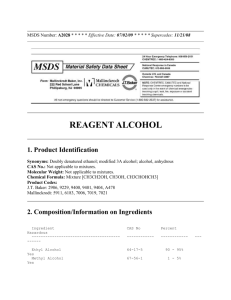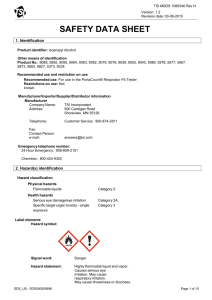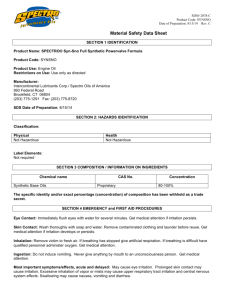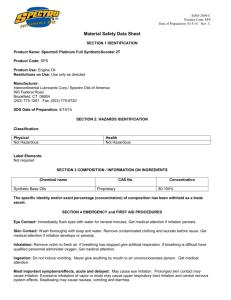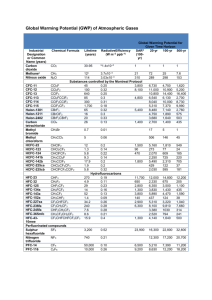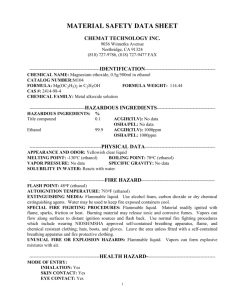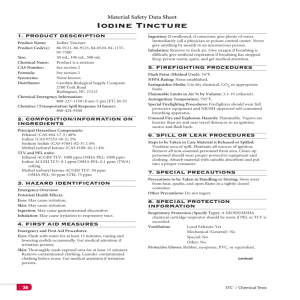Material Safety Data Sheet - Avantor Performance Materials
advertisement
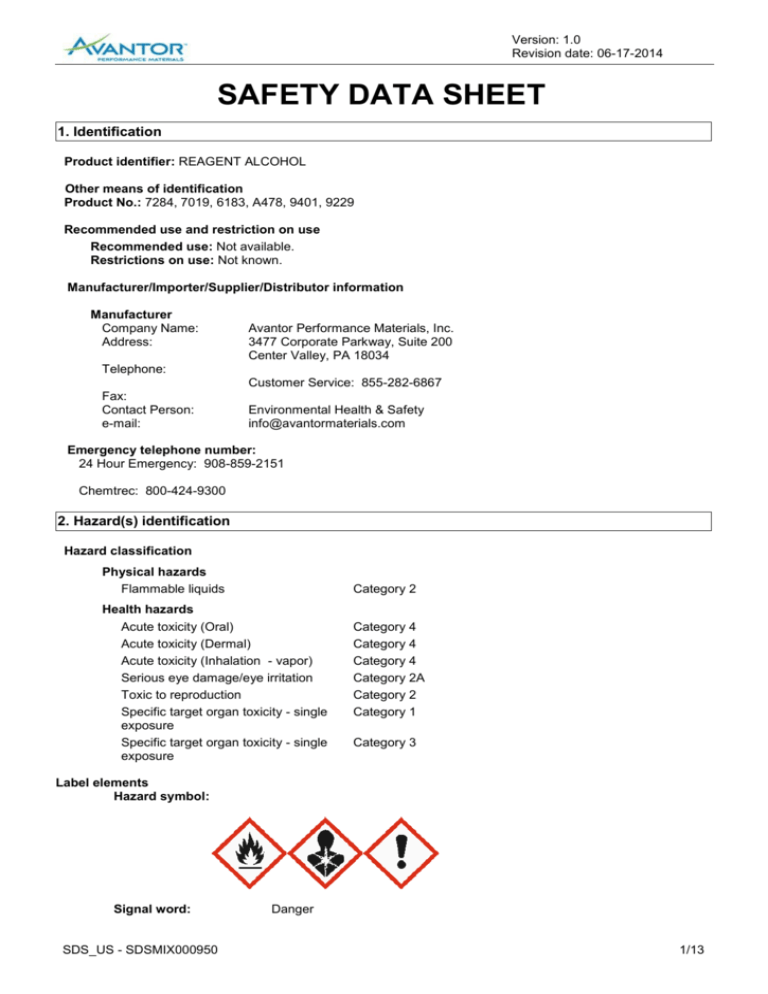
Version: 1.0 Revision date: 06-17-2014 SAFETY DATA SHEET 1. Identification Product identifier: REAGENT ALCOHOL Other means of identification Product No.: 7284, 7019, 6183, A478, 9401, 9229 Recommended use and restriction on use Recommended use: Not available. Restrictions on use: Not known. Manufacturer/Importer/Supplier/Distributor information Manufacturer Company Name: Address: Avantor Performance Materials, Inc. 3477 Corporate Parkway, Suite 200 Center Valley, PA 18034 Telephone: Customer Service: 855-282-6867 Fax: Contact Person: e-mail: Environmental Health & Safety info@avantormaterials.com Emergency telephone number: 24 Hour Emergency: 908-859-2151 Chemtrec: 800-424-9300 2. Hazard(s) identification Hazard classification Physical hazards Flammable liquids Category 2 Health hazards Acute toxicity (Oral) Acute toxicity (Dermal) Acute toxicity (Inhalation - vapor) Serious eye damage/eye irritation Toxic to reproduction Specific target organ toxicity - single exposure Specific target organ toxicity - single exposure Category 4 Category 4 Category 4 Category 2A Category 2 Category 1 Category 3 Label elements Hazard symbol: Signal word: SDS_US - SDSMIX000950 Danger 1/13 Version: 1.0 Revision date: 06-17-2014 Hazard statement: Highly flammable liquid and vapor. Harmful if swallowed. Harmful in contact with skin. Harmful if inhaled. Causes serious eye irritation. May cause respiratory irritation. Suspected of damaging fertility. May cause damage to organs. Precautionary statement Prevention: Obtain special instructions before use. Do not handle until all safety precautions have been read and understood. Keep away from heat/sparks/open flames/hot surfaces. No smoking. Keep container tightly closed. Ground/bond container and receiving equipment. Use explosionproof electrical/ventilating/lighting/equipment. Use only non-sparking tools. Take precautionary measures against static discharge. Wear protective gloves/protective clothing/eye protection/face protection. Do not breathe dust/fume/gas/mist/vapors/spray. Wash thoroughly after handling. Do not eat, drink or smoke when using this product. Use only outdoors or in a wellventilated area. Response: In case of fire: Use water spray, foam, dry powder or carbon dioxide for extinction. IF exposed: Call a POISON CENTER or doctor/physician. IF INHALED: Remove victim to fresh air and keep at rest in a position comfortable for breathing. Call a POISON CENTER or doctor/physician if you feel unwell. IF ON SKIN (or hair): Remove/take off immediately all contaminated clothing. Rinse skin with water/shower. If skin irritation occurs: Get medical advice/attention. Wash contaminated clothing before reuse. IF IN EYES: Rinse cautiously with water for several minutes. Remove contact lenses, if present and easy to do. Continue rinsing. If eye irritation persists: Get medical advice/attention. IF SWALLOWED: Call a POISON CENTER or doctor/physician if you feel unwell. Rinse mouth. Storage: Store locked up. Store in a well-ventilated place. Keep container tightly closed. Disposal: Dispose of contents/container to an appropriate treatment and disposal facility in accordance with applicable laws and regulations, and product characteristics at time of disposal. Other hazards which do not result in GHS classification: Static accumulating flammable liquid can become electrostatically charged even in bonded and grounded equipment. Sparks may ignite liquid and vapor. May cause flash fire or explosion. 3. Composition/information on ingredients Mixtures CAS number Content in percent (%)* ETHANOL 64-17-5 88 - 92% ISOPROPYL ALCOHOL 67-63-0 4 - 6% METHYL ALCOHOL 67-56-1 2.5 - 10% Chemical identity Common name and synonyms * All concentrations are percent by weight unless ingredient is a gas. Gas concentrations are in percent by volume. 4. First-aid measures SDS_US - SDSMIX000950 2/13 Version: 1.0 Revision date: 06-17-2014 General information: Get medical advice/attention if you feel unwell. Show this safety data sheet to the doctor in attendance. Ingestion: Rinse mouth. Call a POISON CENTER or doctor/physician if you feel unwell. Inhalation: Move to fresh air. Get medical attention if symptoms occur. Skin contact: Wash skin thoroughly with soap and water. Get medical attention if symptoms occur. Wash contaminated clothing before reuse. Eye contact: Immediately flush with plenty of water for at least 15 minutes. If easy to do, remove contact lenses. If eye irritation persists: Get medical advice/attention. Most important symptoms/effects, acute and delayed Symptoms: Harmful if inhaled. Harmful if swallowed. Irritating to eyes, respiratory system and skin. Indication of immediate medical attention and special treatment needed Treatment: Symptoms may be delayed. Treat symptomatically. 5. Fire-fighting measures General fire hazards: In case of fire and/or explosion do not breathe fumes. Vapors may cause a flash fire or ignite explosively. Suitable (and unsuitable) extinguishing media Suitable extinguishing media: Water spray, foam, dry powder or carbon dioxide. Unsuitable extinguishing media: Avoid water in straight hose stream; will scatter and spread fire. Specific hazards arising from the chemical: Vapors may cause a flash fire or ignite explosively. Vapors may travel considerable distance to a source of ignition and flash back. Prevent buildup of vapors or gases to explosive concentrations. Special protective equipment and precautions for firefighters Special fire fighting procedures: Use water spray to keep fire-exposed containers cool. Water may be ineffective in fighting the fire. Fight fire from a protected location. Move containers from fire area if you can do so without risk. Special protective equipment for fire-fighters: Firefighters must use standard protective equipment including flame retardant coat, helmet with face shield, gloves, rubber boots, and in enclosed spaces, SCBA. 6. Accidental release measures Personal precautions, protective equipment and emergency procedures: SDS_US - SDSMIX000950 Use personal protective equipment. Keep unauthorized personnel away. Keep upwind. Ventilate closed spaces before entering them. Do not touch damaged containers or spilled material unless wearing appropriate protective clothing. 3/13 Version: 1.0 Revision date: 06-17-2014 Methods and material for containment and cleaning up: Eliminate all ignition sources if safe to do so. Absorb spill with vermiculite or other inert material, then place in a container for chemical waste. Collect in a non-combustible container for prompt disposal. Clean surface thoroughly to remove residual contamination. Dike far ahead of larger spill for later recovery and disposal. Notification Procedures: Dike for later disposal. Prevent entry into waterways, sewer, basements or confined areas. Stop the flow of material, if this is without risk. Inform authorities if large amounts are involved. Environmental precautions: Do not contaminate water sources or sewer. Prevent further leakage or spillage if safe to do so. Avoid discharge into drains, water courses or onto the ground. 7. Handling and storage Precautions for safe handling: DO NOT handle, store or open near an open flame, sources of heat or sources of ignition. Protect material from direct sunlight. Take precautionary measures against static discharges. Use personal protective equipment as required. Avoid inhalation of vapors and spray mists. Avoid contact with eyes, skin, and clothing. Do not taste or swallow. Use only with adequate ventilation. Wash hands thoroughly after handling. See Section 8 of the MSDS for Personal Protective Equipment. Conditions for safe storage, including any incompatibilities: Keep away from food, drink and animal feeding stuffs. Keep container tightly closed. Keep in a cool, well-ventilated place. Ground container and transfer equipment to eliminate static electric sparks. Comply with all national, state, and local codes pertaining to the storage, handling, dispensing, and disposal of flammable liquids. SDS_US - SDSMIX000950 4/13 Version: 1.0 Revision date: 06-17-2014 8. Exposure controls/personal protection Control parameters Occupational exposure limits Chemical identity Type ETHANOL STEL ISOPROPYL ALCOHOL METHYL ALCOHOL Exposure Limit values Source REL 1,000 ppm 1,000 ppm 1,900 mg/m3 PEL 1,000 ppm 1,900 mg/m3 TWA 1,000 ppm 1,900 mg/m3 TWA STEL 200 ppm 400 ppm REL 400 ppm STEL 500 ppm 1,225 mg/m3 PEL 400 ppm 980 mg/m3 TWA 400 ppm 980 mg/m3 STEL 500 ppm 1,225 mg/m3 TWA STEL 200 ppm 250 ppm STEL 250 ppm 325 mg/m3 REL 200 ppm 260 mg/m3 PEL 200 ppm 260 mg/m3 TWA 200 ppm 260 mg/m3 STEL 250 ppm 325 mg/m3 980 mg/m3 US. ACGIH Threshold Limit Values (2011) US. NIOSH: Pocket Guide to Chemical Hazards (2010) US. OSHA Table Z-1 Limits for Air Contaminants (29 CFR 1910.1000) (02 2006) US. OSHA Table Z-1-A (29 CFR 1910.1000) (1989) US. ACGIH Threshold Limit Values (2011) US. ACGIH Threshold Limit Values (2011) US. NIOSH: Pocket Guide to Chemical Hazards (2010) US. NIOSH: Pocket Guide to Chemical Hazards (2010) US. OSHA Table Z-1 Limits for Air Contaminants (29 CFR 1910.1000) (02 2006) US. OSHA Table Z-1-A (29 CFR 1910.1000) (1989) US. OSHA Table Z-1-A (29 CFR 1910.1000) (1989) US. ACGIH Threshold Limit Values (2011) US. ACGIH Threshold Limit Values (2011) US. NIOSH: Pocket Guide to Chemical Hazards (2010) US. NIOSH: Pocket Guide to Chemical Hazards (2010) US. OSHA Table Z-1 Limits for Air Contaminants (29 CFR 1910.1000) (02 2006) US. OSHA Table Z-1-A (29 CFR 1910.1000) (1989) US. OSHA Table Z-1-A (29 CFR 1910.1000) (1989) Biological limit values Chemical identity Exposure Limit values ISOPROPYL ALCOHOL (acetone: Sampling time: End of shift at end of work week.) METHYL ALCOHOL (methanol: Sampling time: End of shift.) Appropriate engineering controls Source 40 mg/l (Urine) ACGIH BEL (2011) 15 mg/l (Urine) ACGIH BEL (2011) No data available. Individual protection measures, such as personal protective equipment General information: Good general ventilation (typically 10 air changes per hour) should be used. Ventilation rates should be matched to conditions. If applicable, use process enclosures, local exhaust ventilation, or other engineering controls to maintain airborne levels below recommended exposure limits. If exposure limits have not been established, maintain airborne levels to an acceptable level. An eye wash and safety shower must be available in the immediate work area. Use explosion-proof ventilation equipment. Eye/face protection: Wear safety glasses with side shields (or goggles). Wear face shield if there is risk of splashes. Skin protection Hand protection: Other: SDS_US - SDSMIX000950 Chemical resistant gloves Wear suitable protective clothing. 5/13 Version: 1.0 Revision date: 06-17-2014 Respiratory protection: In case of inadequate ventilation use suitable respirator. Hygiene measures: Provide eyewash station and safety shower. Always observe good personal hygiene measures, such as washing after handling the material and before eating, drinking, and/or smoking. Routinely wash work clothing to remove contaminants. Discard contaminated footwear that cannot be cleaned. 9. Physical and chemical properties Appearance Physical state: Liquid Form: Liquid Color: Colorless Odor: Mild pleasant odor Odor threshold: No data available. pH: No data available. Melting point/freezing point: -114 °C Initial boiling point and boiling range: 78 °C Flash Point: 13 °C Evaporation rate: No data available. Flammability (solid, gas): No data available. Upper/lower limit on flammability or explosive limits Flammability limit - upper (%): 19 %(V) Flammability limit - lower (%): 3.3 %(V) Explosive limit - upper (%): No data available. Explosive limit - lower (%): No data available. Vapor pressure: 8.1 kPa Vapor density: No data available. Relative density: 0.79 (20 °C) Solubility(ies) Solubility in water: Soluble Solubility (other): No data available. Partition coefficient (n-octanol/water): No data available. Auto-ignition temperature: 422 °C Decomposition temperature: No data available. Viscosity: No data available. 10. Stability and reactivity Reactivity: No dangerous reaction known under conditions of normal use. Chemical stability: Material is stable under normal conditions. Possibility of hazardous reactions: Hazardous polymerization does not occur. Conditions to avoid: Heat, sparks, flames. Contact with incompatible materials. Incompatible materials: Strong oxidizing agents. Alkali metals. Inorganic salts. Organic organometallic. Inorganic hydrides. Hazardous decomposition products: Thermal decomposition may release oxides of carbon. SDS_US - SDSMIX000950 6/13 Version: 1.0 Revision date: 06-17-2014 11. Toxicological information Information on likely routes of exposure Ingestion: Harmful if swallowed. Inhalation: Harmful if inhaled. May cause irritation to the respiratory system. Skin contact: Harmful if absorbed through skin. Causes mild skin irritation. Eye contact: Causes serious eye irritation. Information on toxicological effects Acute toxicity (list all possible routes of exposure) Oral Product: Specified substance(s): ETHANOL Specified substance(s): ISOPROPYL ALCOHOL Specified substance(s): METHYL ALCOHOL Dermal Product: Specified substance(s): ISOPROPYL ALCOHOL Specified substance(s): METHYL ALCOHOL Inhalation Product: No data available. LD 50 (Rat): 6,200 mg/kg LD 50 (Rat): 5,045 mg/kg LD 50 (Rat): 5,628 mg/kg LD 50 (Rabbit): 14,400 mg/kg No data available. LD 50 (Rabbit): 12,800 mg/kg LD 50 (Rabbit): 15,800 mg/kg No data available. Specified substance(s): ETHANOL LC 50 (Rat, 10 h): 20,000 mg/l Specified substance(s): ISOPROPYL ALCOHOL No data available. Specified substance(s): METHYL ALCOHOL LC 50 (Rat, 6 h): 87.5 mg/l Repeated dose toxicity Product: Skin corrosion/irritation Product: No data available. Causes mild skin irritation. Serious eye damage/eye irritation Product: Causes serious eye irritation. Respiratory or skin sensitization Product: Not a skin sensitizer. Carcinogenicity Product: SDS_US - SDSMIX000950 This substance has no evidence of carcinogenic properties. 7/13 Version: 1.0 Revision date: 06-17-2014 IARC Monographs on the Evaluation of Carcinogenic Risks to Humans: ETHANOL Overall evaluation: 1. Carcinogenic to humans. Overall evaluation: 1. Carcinogenic to humans. ISOPROPYL ALCOHOL Overall evaluation: 1. Carcinogenic to humans. Overall evaluation: 3. Not classifiable as to carcinogenicity to humans. US. National Toxicology Program (NTP) Report on Carcinogens: ETHANOL Known To Be Human Carcinogen. US. OSHA Specifically Regulated Substances (29 CFR 1910.1001-1050): No carcinogenic components identified Germ cell mutagenicity In vitro Product: No mutagenic components identified In vivo Product: No mutagenic components identified Reproductive toxicity Product: May damage fertility or the unborn child. Specific target organ toxicity - single exposure Product: Central nervous system. Eyes. Respiratory tract irritation. Specific target organ toxicity - repeated exposure Product: None known. Aspiration hazard Product: Other effects: Not classified None known. 12. Ecological information Ecotoxicity: Acute hazards to the aquatic environment: Fish Product: Specified substance(s): ETHANOL No data available. LC 50 (Rainbow trout,donaldson trout (Oncorhynchus mykiss), 96 h): 12,000 - 16,000 mg/l Mortality LC 50 (Fathead minnow (Pimephales promelas), 96 h): 13,480 mg/l Mortality LC 50 (Carp (Leuciscus idus melanotus), 48 h): 8,140 mg/l Mortality ISOPROPYL ALCOHOL LC 50 (Fathead minnow (Pimephales promelas), 96 h): 5,770 - 7,450 mg/l Mortality LC 50 (Bluegill (Lepomis macrochirus), 96 h): > 1,400 mg/l Mortality LC 50 (Western mosquitofish (Gambusia affinis), 96 h): > 1,400 mg/l Mortality METHYL ALCOHOL LC 50 (Rainbow trout,donaldson trout (Oncorhynchus mykiss), 96 h): 18,000 - 20,000 mg/l Mortality LC 50 (Fathead minnow (Pimephales promelas), 96 h): 28,200 mg/l Mortality SDS_US - SDSMIX000950 8/13 Version: 1.0 Revision date: 06-17-2014 Aquatic invertebrates Product: Specified substance(s): ETHANOL No data available. EC 50 (Water flea (Daphnia obtusa), 48 h): 10,100 - 11,200 mg/l Intoxication LC 50 (Brine shrimp (Artemia franchiscana), 48 h): 25.5 mg/l Mortality LC 50 (Water flea (Daphnia magna), 48 h): 7,560 - 12,600 mg/l Mortality ISOPROPYL ALCOHOL LC 50 (Brine shrimp (Artemia salina), 24 h): > 10,000 mg/l Mortality LC 50 (Water flea (Daphnia magna), 24 h): > 10,000 mg/l Mortality LC 50 (Common shrimp, sand shrimp (Crangon crangon), 96 h): 750 - 1,650 mg/l Mortality METHYL ALCOHOL EC 50 (Water flea (Daphnia magna), 48 h): 20,450 - 29,350 mg/l Intoxication LC 50 (Water flea (Daphnia magna), 48 h): 2,461 - 4,395 mg/l Mortality Chronic hazards to the aquatic environment: Fish Product: No data available. Aquatic invertebrates Product: No data available. Toxicity to Aquatic Plants Product: No data available. Persistence and degradability Biodegradation Product: Expected to be readily biodegradable. BOD/COD ratio Product: No data available. Bioaccumulative potential Bioconcentration factor (BCF) Product: No data available on bioaccumulation. Partition coefficient n-octanol / water (log Kow) Product: No data available. Specified substance(s): ETHANOL Log Kow: -0.31 ISOPROPYL ALCOHOL Log Kow: 0.05 METHYL ALCOHOL Log Kow: -0.77 Mobility in soil: The product is water soluble and may spread in water systems. Other adverse effects: The product components are not classified as environmentally hazardous. However, this does not exclude the possibility that large or frequent spills can have a harmful or damaging effect on the environment. 13. Disposal considerations Disposal instructions: Discharge, treatment, or disposal may be subject to national, state, or local laws. Residual vapors may explode on ignition; do not cut, drill, grind, or weld on or near this container. Contaminated packaging: Since emptied containers retain product residue, follow label warnings even after container is emptied. SDS_US - SDSMIX000950 9/13 Version: 1.0 Revision date: 06-17-2014 14. Transport information DOT UN number: UN proper shipping name: Transport hazard class(es) Class(es): Label(s): Packing group: Marine Pollutant: IMDG UN number: UN proper shipping name: Transport hazard class(es) Class(es): Label(s): EmS No.: Packing group: Marine Pollutant: UN 1987 Alcohols, n.o.s.(ETHANOL, METHANOL, ISOPROPANOL) 3 3 II No UN 1987 ALCOHOLS, N.O.S.(ETHANOL, METHANOL, ISOPROPANOL) 3 3 F-E, S-D II No IATA UN number: Proper Shipping Name: Transport hazard class(es): Class(es): Label(s): Marine Pollutant: Packing group: UN 1987 Alcohols, n.o.s.(ETHANOL, METHANOL, ISOPROPANOL) 3 3 No II 15. Regulatory information US federal regulations TSCA Section 12(b) Export Notification (40 CFR 707, Subpt. D) US. OSHA Specifically Regulated Substances (29 CFR 1910.1001-1050) None present or none present in regulated quantities. CERCLA Hazardous Substance List (40 CFR 302.4): METHYL ALCOHOL Reportable quantity: 5000 lbs. Superfund amendments and reauthorization act of 1986 (SARA) Hazard categories X Acute (Immediate) X Chronic (Delayed) X Fire Reactive Pressure Generating SARA 302 Extremely hazardous substance None present or none present in regulated quantities. SARA 304 Emergency release notification Chemical identity RQ ETHANOL 100 lbs. ISOPROPYL ALCOHOL 100 lbs. METHYL ALCOHOL 5000 lbs. SDS_US - SDSMIX000950 10/13 Version: 1.0 Revision date: 06-17-2014 SARA 311/312 Hazardous chemical Chemical identity Threshold Planning Quantity ETHANOL 500 lbs ISOPROPYL ALCOHOL 500 lbs METHYL ALCOHOL 500 lbs SARA 313 (TRI reporting) Chemical identity METHYL ALCOHOL Reporting threshold for other users 10000 lbs Reporting threshold for manufacturing and processing 25000 lbs. Clean Water Act Section 311 Hazardous Substances (40 CFR 117.3) None present or none present in regulated quantities. Clean Air Act (CAA) Section 112(r) Accidental Release Prevention (40 CFR 68.130): None present or none present in regulated quantities. US state regulations US. California Proposition 65 METHYL ALCOHOL Developmental toxin. WARNING: This product contains a chemical known to the State of California to cause birth defects or other reproductive harm. US. New Jersey Worker and Community Right-to-Know Act ETHANOL Listed ISOPROPYL ALCOHOL Listed METHYL ALCOHOL Listed US. Massachusetts RTK - Substance List ETHANOL Listed ISOPROPYL ALCOHOL Listed METHYL ALCOHOL Listed US. Pennsylvania RTK - Hazardous Substances ETHANOL Listed ISOPROPYL ALCOHOL Listed METHYL ALCOHOL Listed US. Rhode Island RTK ETHANOL ISOPROPYL ALCOHOL METHYL ALCOHOL SDS_US - SDSMIX000950 Listed Listed Listed 11/13 Version: 1.0 Revision date: 06-17-2014 Inventory Status: Australia AICS: Canada DSL Inventory List: EU EINECS List: EU ELINCS List: Japan (ENCS) List: EU No Longer Polymers List: China Inv. Existing Chemical Substances: Korea Existing Chemicals Inv. (KECI): Canada NDSL Inventory: Philippines PICCS: US TSCA Inventory: New Zealand Inventory of Chemicals: Switzerland Consolidated Inventory: Japan ISHL Listing: Japan Pharmacopoeia Listing: On or in compliance with the inventory On or in compliance with the inventory On or in compliance with the inventory Not in compliance with the inventory. On or in compliance with the inventory Not in compliance with the inventory. On or in compliance with the inventory On or in compliance with the inventory Not in compliance with the inventory. On or in compliance with the inventory On or in compliance with the inventory On or in compliance with the inventory Not in compliance with the inventory. Not in compliance with the inventory. Not in compliance with the inventory. 16.Other information, including date of preparation or last revision NFPA Hazard ID 3 2 Flammability 0 Health Reactivity Special hazard. Hazard rating: 0 - Minimal; 1 - Slight; 2 - Moderate; 3 - Serious; 4 - Severe Issue date: 06-17-2014 Revision date: No data available. Version #: 1.0 Further information: No data available. SDS_US - SDSMIX000950 12/13 Version: 1.0 Revision date: 06-17-2014 Disclaimer: SDS_US - SDSMIX000950 THE INFORMATION PRESENTED IN THIS MATERIAL SAFETY DATA SHEET (MSDS/SDS) WAS PREPARED BY TECHNICAL PERSONNEL BASED ON DATA THAT THEY BELIEVE IN THEIR GOOD FAITH JUDGMENT IS ACCURATE. HOWEVER, THE INFORMATION PROVIDED HEREIN IS PROVIDED “AS IS,” AND AVANTOR PERFORMANCE MATERIALS MAKES AND GIVES NO REPRESENTATIONS OR WARRANTIES WHATSOEVER, AND EXPRESSLY DISCLAIMS ALL WARRANTIES REGARDING SUCH INFORMATION AND THE PRODUCT TO WHICH IT RELATES, WHETHER EXPRESS, IMPLIED, OR STATUTORY, INCLUDING WITHOUT LIMITATION<(>,<)> WARRANTIES OF ACCURACY, COMPLETENESS, MERCHANTABILITY, NONINFRINGEMENT, PERFORMANCE, SAFETY, SUITABILITY, STABILITY, AND FITNESS FOR A PARTICULAR PURPOSE, AND ANY WARRANTIES ARISING FROM COURSE OF DEALING, COURSE OF PERFORMANCE, OR USAGE OF TRADE. THIS MSDS/SDS IS INTENDED ONLY AS A GUIDE TO THE APPROPRIATE PRECAUTIONARY HANDLING OF THE MATERIAL BY A PROPERLY TRAINED PERSON USING THIS PRODUCT, AND IS NOT INTENDED TO BE COMPREHENSIVE AS TO THE MANNER AND CONDITIONS OF USE, HANDLING, STORAGE, OR DISPOSAL OF THE PRODUCT. INDIVIDUALS RECEIVING THIS MSDS/SDS MUST ALWAYS EXERCISE THEIR OWN INDEPENDENT JUDGMENT IN DETERMINING THE APPROPRIATENESS OF SUCH ISSUES. ACCORDINGLY, AVANTOR PERFORMANCE MATERIALS ASSUMES NO LIABILITY WHATSOEVER FOR THE USE OF OR RELIANCE UPON THIS INFORMATION. NO SUGGESTIONS FOR USE ARE INTENDED AS, AND NOTHING HEREIN SHALL BE CONSTRUED AS, A RECOMMENDATION TO INFRINGE ANY EXISTING PATENTS OR TO VIOLATE ANY FEDERAL, STATE, LOCAL, OR FOREIGN LAWS. AVANTOR PERFORMANCE MATERIALS REMINDS YOU THAT IT IS YOUR LEGAL DUTY TO MAKE ALL INFORMATION IN THIS MSDS/SDS AVAILABLE TO YOUR EMPLOYEES. 13/13
